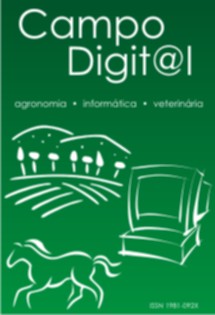<div align="justify">EFICIÊNCIA DE FUNGICIDAS NO CONTROLE DE FERRUGEM DA FOLHA NA CULTURA DO TRIGO
Abstract
A ferrugem da folha limita a produção de trigo no Brasil, o seu controle tem sido feito através de fungicidas. O presente trabalho teve por objetivo avaliar a eficiência de seis fungicidas disponíveis comercialmente. Os tratamentos realizados foram: 1- epoxyconazole+pyraclostrobin (0,74 L ha-1), 2- azoxystrobin+cyproconazole (0,3 L ha-1), 3- cyproconazole + picoxistrobina (0,3 L ha-1), 4- azoxystrobin (0,3 L ha-1), 5- tebuconazole+trifloxystrobin (0,74 L ha-1), 6- tebuconazole (0,62 L ha-1) e 7- testemunha, em duas aplicações. O trabalho totalizou 7 tratamentos com 4 repetições, com um total de 28 parcelas. A aplicação dos fungicidas foi realizada com pulverizador costal de pressão constante de CO2 (50 kgf cm-3), com vazão de 250 L ha-1, sendo que a 1ª aplicação foi realizada na fase de perfilhamento, com o surgimento das primeiras pústulas da doença. A 2ª aplicação foi realizada quando a cultura apresentava 50% de espigamento. As variáveis analisadas foram: AACPD de incidência da ferrugem, produtividade (kg ha-1), PH (Peso hectolitro) e peso de 1000 grãos (g). Os dados foram submetidos à análise de variância pelo teste F, as diferenças quando significativas foram submetidas à análise de Tukey, regressão e análise de correlação. Os fungicidas azoxystrobin + cyproconazole (0,3 L ha-1) e azoxystrobin (0,3 L ha-1) foram mais eficientes no controle da doença, seguidos por, cyproconazole + picoxystrobina (0,3 L ha-1), epoxyconazole + pyraclostrobin (0,74 L ha-1), tebuconazole + trifloxystrobin (0,74 L ha-1) e tebuconazole (0,62 L ha-1). O acréscimo no rendimento de grãos e o peso de 1000 sementes variaram entre os produtos testados, na cultivar CD-104.
EVALUATION OF THE EFFICIENCY OF DIFFERENT FUNGICIDES IN CONTROL OF LEAF RUST IN WHEAT
Abstract
The leaf rust is a disease that limits the production of wheat in Brazil, and its control is realized with fungicides, then the objective of the present study is evaluate the efficiency of six fungicides used commercially. The treatments were: epoxyconazole + pyraclostrobin (0.74 L ha-1), azoxystrobin + cyproconazole (0.3 L ha-1), picoxystrobina + cyproconazole (0.3 L ha-1), azoxystrobin (0.3 L ha-1), tebuconazole + trifloxystrobin (0.74 L ha-1) and tebuconazole (0.62 L ha-1), in two applications. It was made 7 treatments with 4 repetitions, with a total of 28 plots. The application of fungicides was made with costal spray with constant pressure of CO2 (50 kgf cm-3), flow rate of 250 L ha-1, when the crop is in the elongation and the first pustules of the disease appears. The second application are realized when the crop are at 50% of heading. The variables analyzed were: AUDPC incidence of leaf, productivity (kg ha-1), PH and weight of 1000 grains (g). The data were submitted to variance analysis, and when the differences were significant, the data are submitted to test F, correlation and regression analysis. The fungicides cyproconazole + azoxystrobin (0,3 L ha-1) and azoxystrobin (0,3 L ha-1) were more efficient to control disease, followed by cyproconazole + picoxystrobina (0,3 L ha-1), epoxyconazole + pyraclostrobin (0,74 L ha-1), tebuconazole + trifloxystrobin (0,74 L ha-1) and tebuconazole (0,62 L ha-1). The raise of yield grains and weight of 1000 grains were changed in function the products tester on cultivate CD-104.
Downloads
Published
How to Cite
Issue
Section
License
Direitos Autorais para artigos publicados nesta revista são cedidos pelo autor à Revista Campo Digital, que está autorizada a publicá-lo em meio impresso, digital, ou outro existente, sem retribuição financeira para os autores. Em virtude da aparecerem nesta revista de acesso público, os artigos são de uso gratuito, com atribuições próprias, em aplicações educacionais e não-comerciais.










 ISSN 1981-092X
ISSN 1981-092X
